Fact:
On May 8, 2019, Taliban insurgents detonated an explosive-laden vehicle and then broke into American NGO Counterpart International’s offices in Kabul. At least seven people were killed and 24 were injured.
Following is the August 2023 installment of “ISIS Redux: The Central Syria Insurgency,” a monthly chronicle of attacks by the terrorist group ISIS in central Syria. A review of developments throughout 2022 and 2021 can be found here and here. The January 2023 edition can be found here, February’s here, March’s here, April’s here, May’s here, June’s here and July’s here. A full background and analysis of ISIS’s resurgence in Syria, including the methodology used to collect this data, can also be explored here, here, and here.
ISIS carried out at least 17 confirmed attacks in August in the Homs, Hama, Raqqa, and Deir Ez Zor governorates. These attacks killed at least 40 pro-Assad regime soldiers and wounded 21 additional soldiers and two civilians. There were also seven high quality* attacks during August. August was the most violent month in central Syria since the end of ISIS’s spring campaign when the group heavily targeted civilian truffle hunters across eastern Homs and western Deir Ez Zor. However, as in the months following those attacks, August’s activity was focused on regime security forces rather than civilians.
ISIS media took credit for three attacks in the Badia in August, marking eight official ISIS claims for central Syria attacks this year. All eight claims occurred after mid-June, suggesting that there may have been an intentional shift in ISIS media strategy around that time.
The most serious ISIS activity in August was concentrated in Deir Ez Zor and Raqqa. On August 7, ISIS launched multiple attacks on regime checkpoints across western Deir Ez Zor, triggering nearly 24 hours of fighting and leaving more than a dozen soldiers dead and wounded. On August 10, ISIS cells ambushed a small Syrian army convoy on a highway in Dier Ez Zor, killing at least 25 soldiers and destroying two buses. This is the second serious highway ambush in central Syria in as many months. Elsewhere, ISIS’s quiet campaign of assassinations and improvised explosive device (IED) attacks inside the towns along the western bank of the Euphrates River continued, further fueling the likelihood that the group has heavily infiltrated pro-regime security forces in the area. In southern Raqqa, locals reported throughout the month that ISIS cells had established fake checkpoints in the Mansoura and Resafa regions which they used to extort from shepherds and local traders.
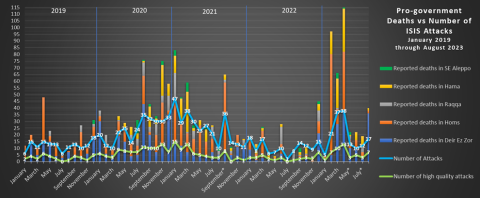
*Indicates attacks in Damascus City claimed by ISIS. Two additional IED attacks occurred in Homs City in June 2023 that went unclaimed but were suspected to be conducted by ISIS.
After two months of stagnation, ISIS attacks doubled in Deir Ez Zor (6), ended a three- month decline in Homs (3) and droped slightly in Hama (4) and Raqqa (2).
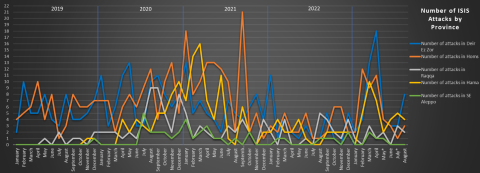
Deir Ez Zor and Raqqa
The number of ISIS attacks in Deir Ez Zor in April (18) was unprecedented, more than in any month since the beginning of the insurgency in 2018. A dramatic reversal was witnessed in May (4), June (3), and July (3). While most of the attacks in these months consisted of mines or IEDs—which would generally be considered a more passive style of attack—these incidents occurred within Deir Ez Zor’s urban centers, rather than in the desert where ISIS traditionally enjoys more freedom of movement. The locations of these attacks support allegations from locals that ISIS has infiltrated local security forces—primarily the pro-regime National Defense Forces (NDF) network. Over the past two years, the NDF has conducted “reconciliation” events designed to bring displaced locals back to the area and have them join the network to complete their mandatory service.
These “infiltrator” style attacks surged in August. First, on August 7, ISIS launched multiple attacks on regime checkpoints across western Deir Ez Zor, leaving at least eight soldiers dead and five wounded over the course of the night. ISIS cells captured the largest regime checkpoint south of Shoula late in the day, resulting in the need to use regime warplanes and IRGC-supported foreign fighters to dislodge the militants during the night. It was not until the morning of August 8 that the ISIS militants withdrew. To the north, an ISIS cell likely based in Jabal Bishri captured one or two checkpoints just outside the town of Maadan Atiq (reports vary), leaving five local NDF dead. The attackers withdrew after looting the position and the arrival of regime reinforcements. However, a few hours later an NDF vehicle was attacked at a fake checkpoint further south along the highway, leaving three men dead and five wounded. The fake checkpoint was likely established by the same cell the conducted the raid near Maadan Atiq.
On August 8, a local pro-regime militia fighter was shot dead outside his village of Kashmeh, south of Mayadeen. On August 10, ISIS cells ambushed a small Syrian Army convoy on the Mayadeen-T2 highway, killing at least 25 soldiers and destroying two buses. On August 13, ISIS members conducted an evening attack at the Salt Mine in western Deir Ez Zor. On August 17, a police officer was gunned down outside of his home within the city of Mayadeen and on August 25, a soldier was reported killed somewhere in the governorate.
In southern Raqqa, locals reported throughout the month that ISIS cells had established fake checkpoints in the Mansoura and Resafa regions, which they used to extort from shepherds and local traders. This author was informed of at least one of these checkpoints operating on August 15 near Mansoura. On August 16, an NDF patrol hit an IED near Resafa, leaving two soldiers wounded. These attacks follow renewed financial activity in the area in late July, when ISIS cells ambushed a group of shepherds just outside of Maadan.
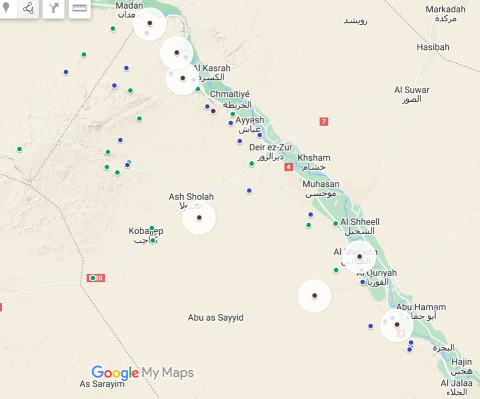
Map of locatable ISIS attacks in Dier Ez Zor (highlighted) in August 2023 alongside all other attacks in 2023. Not mapped is one attack that occurred somewhere in the Deir Ez Zor countryside.
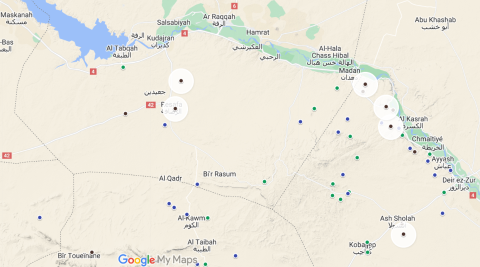
Map of locatable ISIS attacks in west Dier Ez Zor and Raqqa (highlighted) in August 2023 alongside all other attacks in 2023.
Homs and Hama
Confirmed ISIS activity continues to be muted in eastern Homs since the end of the month-long battles around al-Kawm village in April. In August, there were three confirmed ISIS attacks in the province, all in the southeast. On August 16, a soldier from the regime’s 3rd Division was killed when he “entered a mine field”—according to loyalist media—somewhere near the 55km Tanf zone. Also on August 16, a second soldier was killed also near al-Tanf, though whether it was from an explosive or shooting was not specified. On August 29, local security forces reported that ISIS cells had taken hold of a small abandoned hamlet east of Humaymah, also near the Tanf zone and along the Homs-Deir Ez Zor administrative border. It is not clear if there was any security presence nearby when ISIS moved in.
ISIS activity remained high in east Hama, where the group has gradually been increasing its presence since February of this year. On August 3, ISIS claimed to have conducted two IED attacks targeting military vehicles east and west of the town of Ithriyah. On August 28, two local regime fighters were killed by a mine or IED while patrolling south of the town of Sheikh Hilal. On August 29, two children were wounded by a mine outside their village of Soha, near Uqayribat.
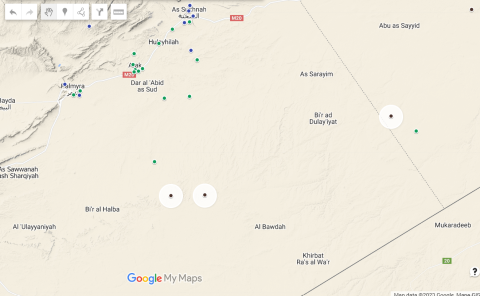

Map of locatable ISIS attacks in Homs (1) and Hama (2) (highlighted) in August 2023 alongside all other attacks in 2023.
Looking Ahead
Each month, several trends are becoming clearer across the Badia. Firstly, ISIS has refocused its efforts in eastern Hama, which had served as a key financing region for the group in past years. Secondly, ISIS militants have likely infiltrated security forces in Deir Ez Zor and southern Raqqa, enabling the group to continually conduct attacks within or close to urban centers. According to local activists who spoke with this author this year, ISIS retains many supporters in southern Raqqa, including former ISIS commanders now serving within the regime’s NDF Raqqa center. And lastly, ISIS appears to have directed resources towards infiltrating Damascus and Homs cities in order to conduct IED attacks against regime forces. It is not clear how sustainable these operations will be.
The impact of the recent violence in eastern Deir Ez Zor on ISIS’s insurgency remains to be seen. However, the U.S.-led Coalition appears to have not stepped in to end the fighting, resulting in their allied Syrian Democratic Forces (SDF) slowly retaking major towns from local tribal forces in part due to the new use of artillery. The mounting civilian casualties and growing likelihood that the conflict will be “resolved” militarily rather than through a negotiated settlement does not bode well for future stability. It is unlikely that the SDF or Coalition will be able to maintain effective local intelligence networks should locals in eastern Deir Ez Zor feel that the SDF has retained its power in the region without addressing any of their core security and governance concerns. This will severely hamper the defeat ISIS campaign and may allow ISIS cells to regain some degree of power in the region. If ISIS finds that eastern Deir Ez Zor has become a more permeable operating environment, then the group may shift some resources out of central Syria, which could impact the level of ISIS activity there in short term.
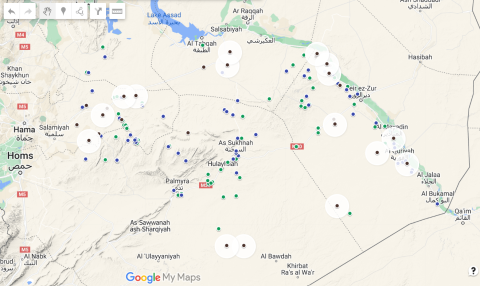
Map of locatable ISIS attacks (highlighted) in August 2023 alongside all other attacks in 2023 (green for Quarter 1 and blue for Quarter 2). Not shown is one attack somewhere in Deir Ez Zor. To view an interactive version of this map, please click here.
*High quality attacks are defined as attacks behind frontlines, those that result in seized positions, target regime officers, involve coordinated attacks on multiple positions, fake checkpoints, ambushes on military convoys, or attacks on checkpoints that kill at least three soldiers or lead to POWs.
Extremists: Their Words. Their Actions.
Fact:
On May 8, 2019, Taliban insurgents detonated an explosive-laden vehicle and then broke into American NGO Counterpart International’s offices in Kabul. At least seven people were killed and 24 were injured.
Get the latest news on extremism and counter-extremism delivered to your inbox.